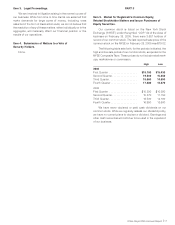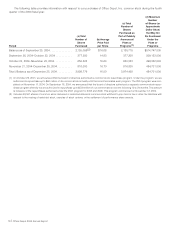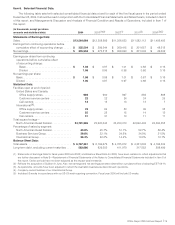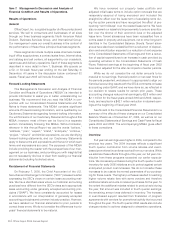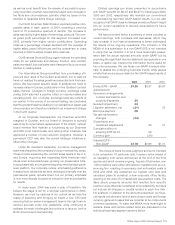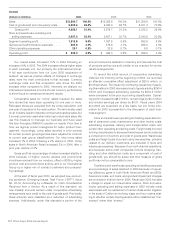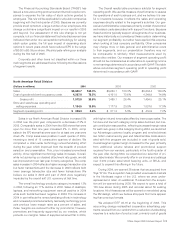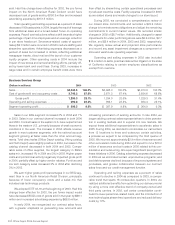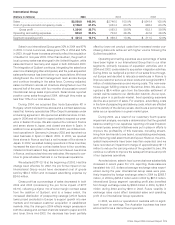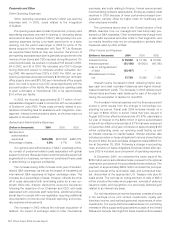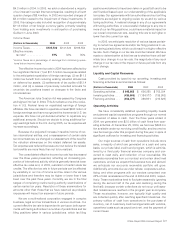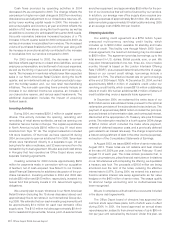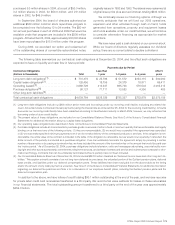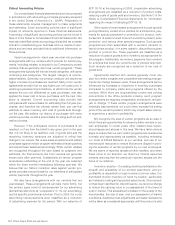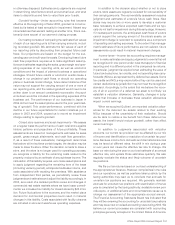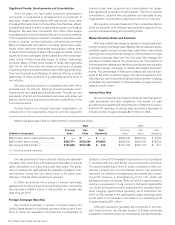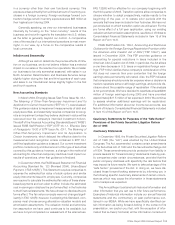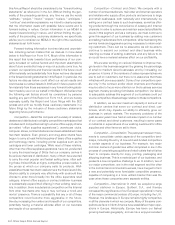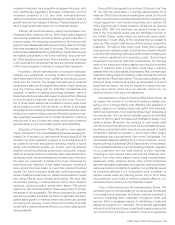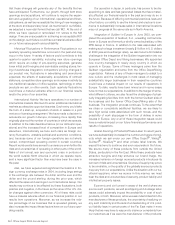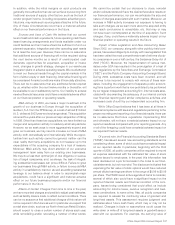Office Depot 2004 Annual Report Download - page 29
Download and view the complete annual report
Please find page 29 of the 2004 Office Depot annual report below. You can navigate through the pages in the report by either clicking on the pages listed below, or by using the keyword search tool below to find specific information within the annual report.
$4.3 million in 2004. In 2003, we sold or abandoned a majority
of our interest in certain Internet companies, resulting in a fourth
quarter charge of $8.4 million. In 2002 we recorded charges of
$3.0 million related to the impairment of these investments. In
2003, this category also included recognition of approximately
$11.8 million of net foreign currency gains, primarily resulting
from holding euro investments in anticipation of purchasing
Guilbert in June 2003.
Income Taxes
(Dollars in thousands) 2004 2003 2002
Income Taxes . . . . . . . . . $125,729 $141,524 $166,554
Effective income
tax rate* . . . . . . . . . . . 27% 32% 35%
*Income Taxes as a percentage of earnings from continuing opera-
tions before income taxes.
The effective income tax rate in 2004 has been affected by
four significant factors: (1) an $11.5 million tax expense related
to the anticipated repatriation of foreign earnings, (2) an $11.3
million tax benefit from reducing existing valuation allowances
on deferred tax assets, (3) settlements of tax audits of $12.4
million, and (4) a release of previously recorded accruals for
uncertain tax positions based on changes in the facts and
circumstances.
The American Jobs Creation Act was passed by Congress
and signed into law in 2004. This Act allows a one-time reduc-
tion in U.S. Federal taxes on repatriated earnings of foreign
affiliates. We have decided to repatriate at least $200 million of
foreign earnings and have recognized the incremental U.S. tax
expense. We have not yet decided whether to repatriate any
additional amounts. Should we decide to bring additional for-
eign earnings back to the U.S. during 2005, our tax expense will
increase accordingly.
Because of a projected increase in taxable income of cer-
tain international entities, and a reassessment of certain state
tax circumstances, we changed our assessment of the need for
the valuation allowances on the related deferred tax assets.
Tax expense was reduced because we now believe the related
tax benefits are more likely than not to be realized.
The consolidated effective income tax rate has decreased
over the three years presented, reflecting an increasing pro-
portion of international activity, which is generally taxed at lower
effective tax rates and, in 2003, realization of certain state tax
credits. The effective tax rate in future periods can be affected
by variability in our mix of income and tax rates in the various
jurisdictions and therefore may be higher or lower than it has
been over the past three years. Currently, we are in the final
stages of completing routine taxing authority examinations of
certain earlier tax years. Resolution of these examinations for
amounts other than those that we have reserved as probable
exposures will impact tax expense in future periods.
We are a multi-national corporation engaged in complex
business, legal and tax transactions in various countries. Our
current effective tax rate is dependent in part upon both agree-
ments with taxing authorities in a number of jurisdictions and tax
filing positions taken in various jurisdictions, which tax filing
positions we believe to have been taken in good faith and to be
well founded based upon our understanding of the applicable
tax codes. Our agreements with tax authorities and our tax filing
positions are subject to ongoing review by us and by various
taxing authorities. A material change in any of our agreements
with taxing authorities, or a successful challenge to any one or
more of our tax filing positions, could have a material impact on
our overall corporate tax rate, causing this rate to be higher or
lower than the current tax rate.
In 2005, we anticipate resolution of various issues pertain-
ing to certain tax agreements and/or tax filing positions in var-
ious taxing jurisdictions, which could result in a higher effective
tax rate. Such change in our tax rate could be material. We have
made no determination at this time as to whether there will def-
initely be a change in our tax rate, the magnitude of any such
change in our tax rate or the impact on future periods from any
such change.
Liquidity and Capital Resources
Cash provided by (used in) our operating, investing and
financing activities is summarized as follows:
(Dollars in thousands) 2004 2003 2002
Operating activities . . . $ 645,865 $ 656,280 $ 702,334
Investing activities . . . . (426,606) (1,184,377) (199,903)
Financing activities . . . (256,477) 388,851 (212,625)
Operating Activities
We have consistently satisfied operating liquidity needs
and planned capital expenditure programs through our normal
conversion of sales to cash. Over the three years ended in
2004, we generated over $2.0 billion of cash flows from oper-
ating activities. At December 25, 2004, we had over $565 mil-
lion available under our revolving credit facility, and incurred no
new borrowings under this program during this year, in spite of
significant outflows for investing and financing activities.
Our major sources of cash from operations include: store
sales, a majority of which are generated on a cash and carry
basis, our private label credit card program, which is adminis-
tered by a third party financial services company and con-
verted to cash daily, and collection of our receivables. We
generate receivables from our contract and certain direct mail
customers, and as we expand this business here and abroad,
we anticipate our accounts receivable portfolio will grow.
Additionally, amounts due us under rebate, cooperative adver-
tising, and other programs with our vendors comprised over
25% of total receivables at the end of 2004 and 2003, respec-
tively. These receivables tend to fluctuate seasonally (growing
during the second half of the year and declining during the
first half), because certain collections do not occur until spec-
ified milestones are reached or the program year is complete.
These receivables, however, are typically high quality and
are collected quickly after reaching specified milestones. Our
primary outflow of cash from operations is the purchase of
inventory, net of customary credit arrangements with vendors,
operational costs such as payroll and rent, and the payment of
current taxes.
Office Depot 2004 Annual Report |27


